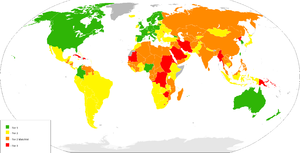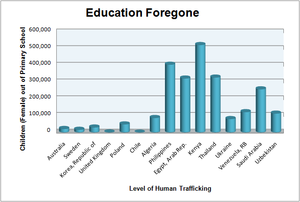| Trafficking In Persons Report Map 2010 (Photo credit: Wikipedia) |
By Lawrence W. Daly, MSc
Forensic Expert – Senior Author
As a parent you never dream that your daughter will be abducted and turned into a sex slave, not a prostitute but a situation where young woman are put into a slavery situation where there are no paychecks or opportunities for advancements in the job market. Human trafficking is a reality in a country which is founded on the freedom to do what you want, making your own decisions, and having the rights to be free from physical, sexual, emotional, and mental abuse.
Human trafficking didn’t just begin yesterday. In fact, the stealing of young women to turn them into sex slaves has been happening for centuries, if not since the beginning of time. Sex sells so the desire to rob children and women of their innocence is financially worth the risk.
Law enforcement has been playing catch up when it comes to the illegal trade of human beings mainly for the purposes of commercial sexual exploitation or forced labor (Wikipedia, 2012). The United Nations in 2000 adopted an international legal agreement which began dealing with the human
trafficking problem.
In 2010 the United Nation and 117 countries and 137 parties ratified the Trafficking Protocol. The protocol is intended to stop the recruitment, transportation, transfer…harboring or receipt of a child for the purpose of exploitation shall be considered “trafficking in persons”… (Trafficking Protocol, 2003).
The Homeland Security began combating human trafficking by creating the Blue Campaign in 2010. Accordi
| WASHINGTON, DC - OCTOBER 04: U.S. Secretary of Homeland Security Janet Napolitano (2nd L) speaks as Secretary of Transportation Ray LaHood (2nd R) and Amtrak President and CEO Joseph Boardman (L) listen during a news conference at Union Station October 4, 2012 in Washington, DC. A new partnership among the Department of Homeland Security (DHS), Department of Transportation (DOT) and Amtrak was announced at the news conference to train over 8,000 frontline transportation employees and Amtrak Police Department officers to combat human trafficking. (Image credit: Getty Images via @daylife) |
ng to the Homeland Security website, “The Blue Campaign, unifying the DSHS components to more effectively combat human trafficking through enhanced public awareness, training, victim assistance, and law enforcement investigations.”
Law enforcement has minimal training and education of their personnel due to the ideology that human trafficking is not happening in my city, county, state, or country. This obsolete and ignorant belief system has begun to change over the past couple decades, but is still not given the priority which it deserves. There have been a multitude of task forces developed which are addressing the human trafficking problem.
The education and training for law enforcement in how to investigate a human trafficking allegation needs to occur in all jurisdictions. Homeland Security has taken this crime and put in the necessary resources to address this major crime. Most law enforcement officials believe human trafficking only occurs in third world countries. This belief is based on bad information and demonstrates a need for law enforcement to examine and explore just how big of a problem human trafficking is in their community. However, there are recognized populations which are vulnerable to human trafficking.
Human trafficking as the United Nations defined it is all about the acts of recruiting, harboring, transporting, providing, and obtaining. The acts are accomplished by the means of force, fraud, or coercion. Further, the purpose is for exploitation, involuntary servitude, peonage, debt bondage, and slavery or any commercial sex act involving a minor. Law enforcement officials need to understand this information provided by Homeland Security and ascertain if any of these types of situations are occurring in their community.
There needs to be education and training not only for law enforcement officials but for the citizens of the United States. An educated individual may save the life of a minor who has been smuggled or put into the tunnel of human trafficking. If the citizen can recognize the characteristics which surround these crimes, then just maybe they will use their mobile telephone and call law enforcement.
In order for law enforcement to investigate an allegation they must understand the difference between human trafficking and human smuggling. The United Nations and Homeland Security defined what is human trafficking. Human smuggling which is just as serious is the transportation of minors from different countries into the United States for the evasion of immigration laws.
Law enforcement needs to examine, evaluate, and investigate human trafficking by knowing the following trafficking indications. They are:
1. Upon arrival to a dispute the victim of human trafficking can’t produce any identification of who they are to law enforcement officers. Further, their relationship to the alleged perpetrators is difficult to establish because the victim, who fears for her life, and the perpetrators who don’t want to be incarcerated will unlikely cooperate with law enforcement.
2. Upon arrival to a dispute upon contacting the victim of human trafficking law enforcement may observe new physical injuries, but more importantly there appears to be scars from past abuse on her. When the officers attempt to interview the victim, she doesn’t cooperate.
3. During an investigation law enforcement officers perform a background into the alleged victims and perpetrators and there are issues which seem to be unexplainable in how the two crossed paths. The victims lack of cooperation can be an indicator that their benchmarks in the community do not appear to be employment or education related. Does the victim have the freedom to leave the residence where the complaint was made or the alleged crime was committed?
4. Law enforcements investigation into the background of the victim is able to ascertain that the victim the minor is not from the community in which the investigation occurred. In fact, the minor is from another community 3000 miles away and when asked where her parents are, she either refuses to provide the information or gives false information.
The above characteristics are only a few of the many indicators in dealing with victims and perpetrators of human trafficking. Human trafficking is a real problem and recognition by everyone in the United States that minors are being turned into sex slaves is a reality. Let us look at some of the statistics that support that human trafficking is a problem:
| English: A chart showing positive correlation between level of human trafficking in countries and number of female children out of primary school. (Photo credit: Wikipedia) |
An estimated 2.5 million people are in forced labor (including sexual exploitation) at any given time as a result of trafficking. 161 countries are reported to be affected by human trafficking by being a source, transit, or destination count. People are reported to be trafficked from 127 countries to be exploited in 137 countries, affecting every continent and every type of economy. The majority of trafficking victims are between 18 and 24 years of age. An estimated 1.2 million children are trafficked each year. 95% of victims experienced physical or sexual violence during trafficking (based on data from selected European countries. 43% of victims are used for forced commercial sexual exploitation, of whom 98 percent are women and girls. 32% of victims are used for forced economic exploitation, of whom 56 per cent are women and girls. Many trafficking victims have at least middle-level education (Global Initiative to Fight Human Trafficking, 2012).
The evidence and facts demonstrate that human trafficking is not in some other country, it is happening here. In order to stop the problem from growing into an epidemic, law enforcement must get ahead of the problem. Education and training should be an integral part of police academies curriculums. The advanced education must be offered across America so if there is leakage it can immediately be plugged. A great beginning is for law enforcement to consider the need for investigative change into an allegation of human trafficking is today.

Lawrence W. Daly
206-650-0229
onedaly@onedaly.com
Kent, WA





















0 comments:
Post a Comment